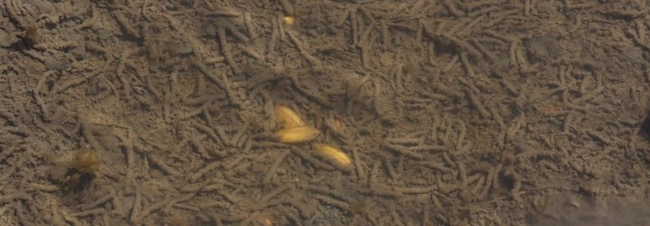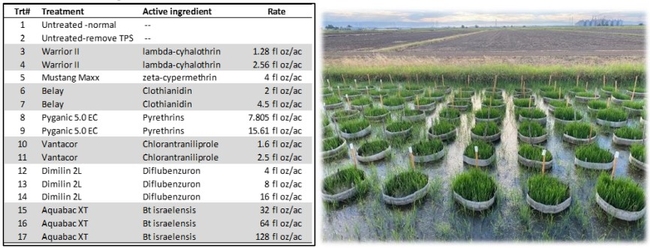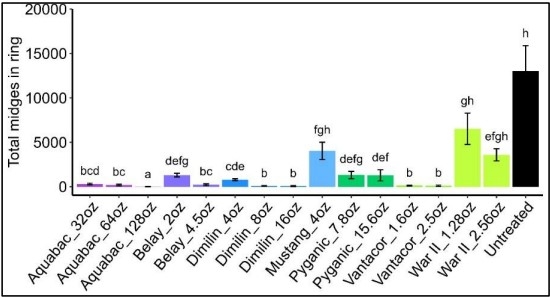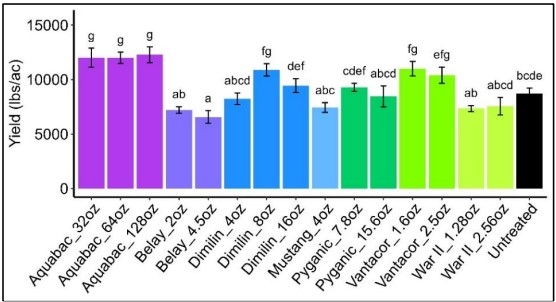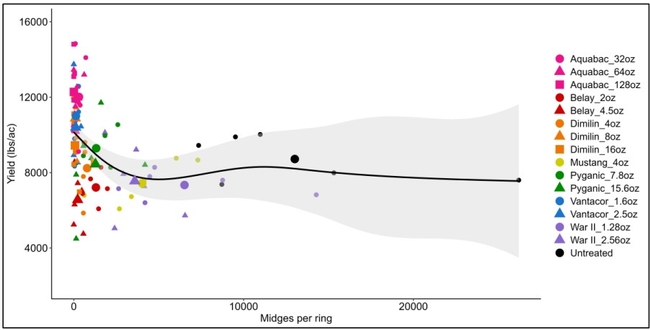Rice seed midge damage was first officially recorded in California rice production in 1953, and this pest is actually a number of different species that are frequently lumped together in terms of defining them as a pest. Midges are some of the first colonizers of freshly flooded rice fields. In high enough numbers, they can cause economic damage to rice during establishment. They often are most problematic in late-planted rice fields or during cool springs when rice struggles to germinate and become established. They have been a spotty but challenging pest in recent years, so we have been working to examine management approaches. Current insecticide programs used for other early season pests like tadpole shrimp may not control rice seed midge.
Management of Rice Seed Midge - Insecticide Trial Results
Mar 20, 2024
Mar 20, 2024
This past year, we conducted a study examining control of midge larvae with insecticides. It was building off of last year's work which indicated that a few materials may help manage seed midge, but many others, especially pyrethroids, seemed to not help or possibly even make matters worse (disrupted biocontrol?). We wanted to test a number of materials and a number of rates. We conducted it with very late-planted rice to exacerbate rice seed midge (it worked!) at the Rice Experiment Station. We used 10.7 ft 2 metal ring plots for our study. Treatments were applied immediately before planting. We sampled for midges using a “scoop mud→wash mud→count bugs” approach 11 days after treating. At the end of the trial, we estimated yield in each ring based on panicle counts. We couldn't just get grain yield because of irregular maturity and most rings simply not fully maturing given the late planting.
Trade name, active ingredient, and rates, used in the rice seed midge trial. Not all materials are currently labeled for rice and/or seed midge.
Overall, we saw some differences in midge counts among treatments, showing variability in efficacy. The untreated had the highest number of midges, followed by the pyrethroid treatments, including Warrior II at both rates and Mustang Maxx, which were all statistically equivalent to the untreated (Figure 1). These pyrethroid treatments were generally equivalent to the Pyganic 5.0 treatments (both rates) and the low rate of Belay, although these had numerically lower counts. Most other treatments had very few midges, which included the Aquabac XT, high rate of Belay, Dimilin, and Vantacor treatments. The high rate of Aquabac XT had the fewest midges overall. Aquabac XT is a Bacillus thuringensis material (israelnsis strain), which relies upon toxins produced by bacteria for their efficacy.
These results were a bit more “pronounced” than our 2022 trial in that the materials generally worked better across the board. The general lack of efficacy we saw with pyrethroids was consistent though. Vantacor and Aquabac XT were especially effective, even at the lower rates we tested, so this is something we think will be worthwhile following up on and learning more about their possible fit in rice IPM.
Figure 1. Rice seed midge abundance in 10.7 sq ft metal ring plots for different treatments. Values represent means across replicates. Means not sharing a level are significantly different based on posthoc comparisons and α = 0.05. Error bars are ± 1 SE.
Other materials were also effective, but there was a mismatch between the yield assessment we made and midge counts. For yield, Aquabac XT clearly provided the best response, along with Vantacor (Fig. 2). What was less clear was what was happening with many of the other treatments. A large number were simply not different than the untreated, even though they did have extremely good midge control. The relationship between plant responses and midge abundance was fairly muddled overall, although it was not just that there was lots of noise. It is possible that there is some sort of difference based on when larvae are affected and die. However, we did treat very early, so this does not seem like it would be the driver. However, no other driver can be suggested otherwise. In Fig. 3, the relationship between midge counts and yield can be seen for the different treatments. It is clear that additional trial data could help elucidate these relationships and clarify if the lack of a yield response for some materials is consistent.
Figure 2. Yield in rings for the rice seed midge trial. There was no effect of treatment. Values represent means across replicates. Means not sharing a level are significantly different based on posthoc comparisons and α = 0.05. Error bars are ± 1 SE.
Of note, we treated these plots early, but not so early that the materials were applied to dry soil as is sometimes done in rice with insecticides. It will also be important to know what happens when rescue treatments are made. It seems like rate of insecticide may come into play a bit more at this timing. It appears that the materials relied upon heavily for tadpole shrimp (pyrethroids) may not also be effective for rice seed midge. Rice seed midge is likely going to remain a pest that can crop up in rice, so we plan to continue to address issues around management.
*If you would like to discuss rice seed midge management, please reach out to Ian or Luis!
